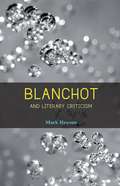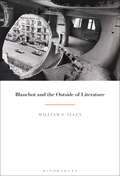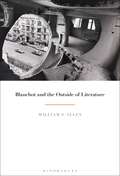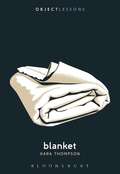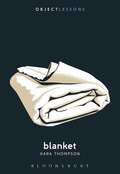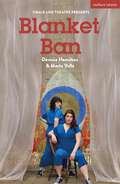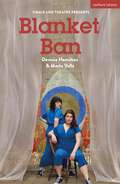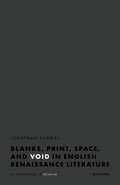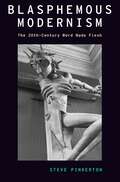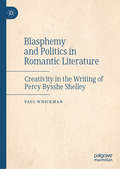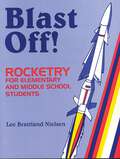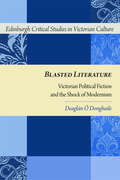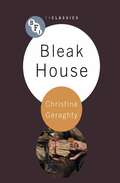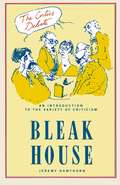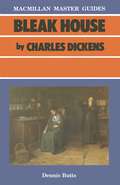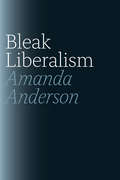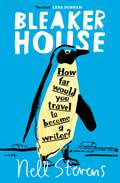- Table View
- List View
Blanchot and Literary Criticism
by Mark HewsonBlanchot's writings on literature have imposed themselves in the canon of modern literary theory and yet have remained a mysterious presence. This is in part due to their almost hypnotic literary style, in part due to their distinctive amalgam of a number of philosophical sources (Hegel, Heidegger, Levinas, Bataille), which, although hardly unknown in the Anglophone philosophical world, have not yet made themselves fully at home in literary theory. This book aims to make visible the coherence of Blanchot's critical project. To recognize the challenge that Blanchot represents for literary criticism, one has to see that he always has in view the self-interrogation that characterizes modern literature, both in its theory and its practice. Blanchot's essays study the forms and the paths of this research, its solutions and its impasses; and increasingly, they sketch out the philosophical and historical horizon within which its significance appears. The effect is to revise the terms in which we see the genesis of the modern literary concept, not least of the manifestations of which is literary criticism itself.
Blanchot and the Outside of Literature
by William S. AllenMaurice Blanchot's writings have played a critical role in the development of 20th-century French thought, but the implicit tension in this role has rarely been addressed directly. Reading Blanchot involves understanding how literature can have an effect on philosophy, to the extent of putting philosophy itself in question by exposing a different and literary mode of thought. However, as this mode is to be found most substantially in the peculiar density of his fictional writings, rather than in his theoretical or critical works, the demand on readers to grasp its implications for thought is rendered more difficult. Blanchot and the Outside of Literature provides a detailed and far-reaching explication of how Blanchot's works changed in the postwar period during which he arrived at this complex and distinctive form of writing.
Blanchot and the Outside of Literature
by William S. AllenMaurice Blanchot's writings have played a critical role in the development of 20th-century French thought, but the implicit tension in this role has rarely been addressed directly. Reading Blanchot involves understanding how literature can have an effect on philosophy, to the extent of putting philosophy itself in question by exposing a different and literary mode of thought. However, as this mode is to be found most substantially in the peculiar density of his fictional writings, rather than in his theoretical or critical works, the demand on readers to grasp its implications for thought is rendered more difficult. Blanchot and the Outside of Literature provides a detailed and far-reaching explication of how Blanchot's works changed in the postwar period during which he arrived at this complex and distinctive form of writing.
Blanket (Object Lessons)
by Kara ThompsonObject Lessons is a series of short, beautifully designed books about the hidden lives of ordinary things. We are born into blankets. They keep us alive and they cover us in death. We pull and tug on blankets to see us through the night or an illness. They shield us in mourning and witness our most intimate pleasures. Curious, fearless, vulnerable, and critical, Blanket interweaves cultural critique with memoir to cast new light on a ubiquitous object. Kara Thompson reveals blankets everywhere--film, art, geology, disasters, battlefields, resistance, home--and transforms an ordinary thing into a vibrant and vital carrier of stories and secrets, an object of inheritance and belonging, a companion to uncover. Object Lessons is published in partnership with an essay series in the The Atlantic.
Blanket (Object Lessons)
by Kara ThompsonObject Lessons is a series of short, beautifully designed books about the hidden lives of ordinary things. We are born into blankets. They keep us alive and they cover us in death. We pull and tug on blankets to see us through the night or an illness. They shield us in mourning and witness our most intimate pleasures. Curious, fearless, vulnerable, and critical, Blanket interweaves cultural critique with memoir to cast new light on a ubiquitous object. Kara Thompson reveals blankets everywhere--film, art, geology, disasters, battlefields, resistance, home--and transforms an ordinary thing into a vibrant and vital carrier of stories and secrets, an object of inheritance and belonging, a companion to uncover. Object Lessons is published in partnership with an essay series in the The Atlantic.
Blanket Ban (Modern Plays)
by Davinia Hamilton Marta VellaWinner of New Diorama, Underbelly and Methuen Drama's Untapped Award 2022Sometimes I'm afraid of this play.Malta: Catholic kitsch, golden sun, deep blue sea, Eurovision - and a blanket ban on abortion.Propelled by three years of interviews with anonymous contributors and their own lived experience, actors and activists Marta and Davinia interrogate Malta's restrictions on the freedom of women.What does it mean for your home to boast the world's most progressive LGBTQIA rights, leading transgender laws – and a population that is almost unanimously anti-choice?Blanket Ban is a rallying cry from award-winning Chalk Line Theatre. This edition was published to coincide with the production at Underbelly Cowgate, Edinburgh, in August 2022.
Blanket Ban (Modern Plays)
by Davinia Hamilton Marta VellaWinner of New Diorama, Underbelly and Methuen Drama's Untapped Award 2022Sometimes I'm afraid of this play.Malta: Catholic kitsch, golden sun, deep blue sea, Eurovision - and a blanket ban on abortion.Propelled by three years of interviews with anonymous contributors and their own lived experience, actors and activists Marta and Davinia interrogate Malta's restrictions on the freedom of women.What does it mean for your home to boast the world's most progressive LGBTQIA rights, leading transgender laws – and a population that is almost unanimously anti-choice?Blanket Ban is a rallying cry from award-winning Chalk Line Theatre. This edition was published to coincide with the production at Underbelly Cowgate, Edinburgh, in August 2022.
Blanks, Print, Space, and Void in English Renaissance Literature: An Archaeology of Absence
by Jonathan SawdayBlanks, Print, Space, and Void in English Renaissance Literature is an inquiry into the empty spaces encountered not just on the pages of printed books in c.1500-1700, but in Renaissance culture more generally. The book argues that print culture in the sixteenth and seventeenth centuries helped to foster the modern idea of the 'gap' (where words, texts, images, and ideas are constructed as missing, lost, withheld, fragmented, or perhaps never devised in the first place). It re-imagines how early modern people reacted not just to printed books and documents of many different kinds, but also how the very idea of emptiness or absence began to be fashioned in a way which still surrounds us. Jonathan Sawday leads the reader through the entire landscape of early modern print culture, discussing topics such as: space and silence; the exploration of the vacuum; the ways in which race and racial identity in early modern England were constructed by the language and technology of print; blackness and whiteness, together with lightness, darkness, and sightlessness; cartography and emptiness; the effect of typography on reading practices; the social spaces of the page; gendered surfaces; hierarchies of information; books of memory; pages constructed as waste or vacant; the genesis of blank forms and early modern bureaucracy; the political and devotional spaces of printed books; the impact of censorship; and the problem posed by texts which lack endings or conclusions. The book itself ends by dwelling on blank or empty pages as a sign of human mortality. Sawday pays close attention to the writings of many of the familiar figures in English Renaissance literary culture - Sidney, Shakespeare, Donne, Jonson, and Milton, for example - as well as introducing readers to a host of lesser-known figures. The book also discusses the work of numerous women writers from the period, including Aphra Behn, Ann Bradstreet, Margaret Cavendish, Lady Jane Gray, Lucy Hutchinson, Æmelia Lanyer, Isabella Whitney, and Lady Mary Wroth.
Blanks, Print, Space, and Void in English Renaissance Literature: An Archaeology of Absence
by Jonathan SawdayBlanks, Print, Space, and Void in English Renaissance Literature is an inquiry into the empty spaces encountered not just on the pages of printed books in c.1500-1700, but in Renaissance culture more generally. The book argues that print culture in the sixteenth and seventeenth centuries helped to foster the modern idea of the 'gap' (where words, texts, images, and ideas are constructed as missing, lost, withheld, fragmented, or perhaps never devised in the first place). It re-imagines how early modern people reacted not just to printed books and documents of many different kinds, but also how the very idea of emptiness or absence began to be fashioned in a way which still surrounds us. Jonathan Sawday leads the reader through the entire landscape of early modern print culture, discussing topics such as: space and silence; the exploration of the vacuum; the ways in which race and racial identity in early modern England were constructed by the language and technology of print; blackness and whiteness, together with lightness, darkness, and sightlessness; cartography and emptiness; the effect of typography on reading practices; the social spaces of the page; gendered surfaces; hierarchies of information; books of memory; pages constructed as waste or vacant; the genesis of blank forms and early modern bureaucracy; the political and devotional spaces of printed books; the impact of censorship; and the problem posed by texts which lack endings or conclusions. The book itself ends by dwelling on blank or empty pages as a sign of human mortality. Sawday pays close attention to the writings of many of the familiar figures in English Renaissance literary culture - Sidney, Shakespeare, Donne, Jonson, and Milton, for example - as well as introducing readers to a host of lesser-known figures. The book also discusses the work of numerous women writers from the period, including Aphra Behn, Ann Bradstreet, Margaret Cavendish, Lady Jane Gray, Lucy Hutchinson, Æmelia Lanyer, Isabella Whitney, and Lady Mary Wroth.
Blasphemous Modernism: The 20th-Century Word Made Flesh (Modernist Literature and Culture)
by Steve PinkertonScholars have long described modernism as "heretical" or "iconoclastic" in its assaults on secular traditions of form, genre, and decorum. Yet critics have paid surprisingly little attention to the related category of blasphemy--the rhetoric of religious offense--and to the specific ways this rhetoric operates in, and as, literary modernism. United by a shared commitment to "the word made flesh," writers such as James Joyce, Mina Loy, Richard Bruce Nugent, and Djuna Barnes made blasphemy a key component of their modernist practice, profaning the very scriptures and sacraments that fueled their art. In doing so they belied T. S. Eliot's verdict that the forces of secularization had rendered blasphemy obsolete in an increasingly godless century ("a world in which blasphemy is impossible"); their poems and fictions reveal how forcefully religion endured as a cultural force after the Death of God. More, their transgressions spotlight a politics of religion that has seldom engaged the attention of modernist studies. Blasphemy respects no division of church and state, and neither do the writers who wield it to profane all manner of coercive dogmas--including ecclesiastical as well as more worldly ideologies of race, class, nation, empire, gender, and sexuality. The late-century example of Salman Rushdie's The Satanic Verses affords, finally, a demonstration of how modernism persists in postwar anglophone literature and of the critical role blasphemy plays in that persistence. Blasphemous Modernism thus resonates with the broader cultural and ideological concerns that in recent years have enriched the scope of modernist scholarship.
Blasphemous Modernism: The 20th-Century Word Made Flesh (Modernist Literature and Culture)
by Steve PinkertonScholars have long described modernism as "heretical" or "iconoclastic" in its assaults on secular traditions of form, genre, and decorum. Yet critics have paid surprisingly little attention to the related category of blasphemy--the rhetoric of religious offense--and to the specific ways this rhetoric operates in, and as, literary modernism. United by a shared commitment to "the word made flesh," writers such as James Joyce, Mina Loy, Richard Bruce Nugent, and Djuna Barnes made blasphemy a key component of their modernist practice, profaning the very scriptures and sacraments that fueled their art. In doing so they belied T. S. Eliot's verdict that the forces of secularization had rendered blasphemy obsolete in an increasingly godless century ("a world in which blasphemy is impossible"); their poems and fictions reveal how forcefully religion endured as a cultural force after the Death of God. More, their transgressions spotlight a politics of religion that has seldom engaged the attention of modernist studies. Blasphemy respects no division of church and state, and neither do the writers who wield it to profane all manner of coercive dogmas--including ecclesiastical as well as more worldly ideologies of race, class, nation, empire, gender, and sexuality. The late-century example of Salman Rushdie's The Satanic Verses affords, finally, a demonstration of how modernism persists in postwar anglophone literature and of the critical role blasphemy plays in that persistence. Blasphemous Modernism thus resonates with the broader cultural and ideological concerns that in recent years have enriched the scope of modernist scholarship.
Blasphemy and Politics in Romantic Literature: Creativity in the Writing of Percy Bysshe Shelley
by Paul WhickmanThis book argues for the importance of blasphemy in shaping the literature and readership of Percy Bysshe Shelley and of the Romantic period more broadly. Not only are perceptions of blasphemy taken to be inextricable from politics, this book also argues for blasphemous ‘irreverence’ as both inspiring and necessitating new poetic creativity. The book reveals the intersection of blasphemy, censorship and literary property throughout the ‘Long Eighteenth Century’, attesting to the effect of this connection on Shelley’s poetry more specifically. Paul Whickman notes how Shelley’s perceived blasphemy determined the nature and readership of his published works through censorship and literary piracy. Simultaneously, Whickman crucially shows that aesthetics, content and the printed form of the physical text are interconnected and that Shelley’s political and philosophical views manifest themselves in his writing both formally and thematically.
Blast Off!: Rocketry for Elementary and Middle School Students
by Leona NielsenPacked with fascinating facts and motivational activities, this book helps you create a thematic unit on rocketry. Lessons include information on the beginning of rocketry and explanations of basic scientific principles of rocket flight. Featuring scientific experiments for students, language activities-even a dramatic play (based on the science of rocketry)-this book is a complete teaching package. Grades 4-8.
Blasted Literature: Victorian Political Fiction and the Shock of Modernism (Edinburgh Critical Studies in Victorian Culture (PDF))
by Deaglán Ó DonghaileBy connecting Fenian and anarchist violence found in popular fiction from the 1880s to the early 1900s with the avant-garde writing of British modernism, Deaglán Donghaile demonstrates that Victorian popular fiction and modernism were directly influenced by the explosive shocks of late nineteenth-century terrorism. For the first time, late-Victorian 'dynamite novels', radical journalism and modernist writing are brought together in provocative readings of Henry James, R L Stevenson, Joseph Conrad and Wyndham Lewis. Key Features *Extensive original archival research from libraries in the UK, Ireland and the US *The first book to examine types of political and literary disruption *Reads Henry James, R L Stevenson and Joseph Conrad in new contexts *Detailed discussion of Wyndham Lewis's avant-garde Vorticist journal BLAST in chapter 4
Blasted Literature: Victorian Political Fiction and the Shock of Modernism (Edinburgh Critical Studies in Victorian Culture (PDF))
by Deaglán Ó DonghaileBy connecting Fenian and anarchist violence found in popular fiction from the 1880s to the early 1900s with the avant-garde writing of British modernism, Deaglán Ó Donghaile demonstrates that Victorian popular fiction and modernism were directly influenced by the explosive shocks of late nineteenth-century terrorism.
Bleak House (BFI TV Classics)
by Christine GeraghtyA new edition to our BFI TV Classics series, this analysis of BBC's Bleak House aims to analyze this critically acclaimed production in terms of its adaptation status, narrative organization, acting, setting and mise-en-scene, while also using it to comment on more general issues in television studies.
Bleak House by Charles Dickens (Bloomsbury Master Guides)
by Dennis ButtsThis ebook is now available from Bloomsbury Academic. Bloomsbury Academic publish acclaimed resources for undergraduate and postgraduate courses across a broad range of subjects including Art & Visual Culture, Biblical Studies, Business & Management, Drama & Performance Studies, Economics, Education, Film & Media, History, Linguistics, Literary Studies, Philosophy, Politics & International Relations, Religious Studies, Social Work & Social Welfare, Study Skills and Theology. Visit bloomsbury.com for more information.
Bleak Liberalism
by Amanda AndersonWhy is liberalism so often dismissed by thinkers from both the left and the right? To those calling for wholesale transformation or claiming a monopoly on “realistic” conceptions of humanity, liberalism’s assured progressivism can seem hard to swallow. Bleak Liberalism makes the case for a renewed understanding of the liberal tradition, showing that it is much more attuned to the complexity of political life than conventional accounts have acknowledged. Amanda Anderson examines canonical works of high realism, political novels from England and the United States, and modernist works to argue that liberalism has engaged sober and even stark views of historical development, political dynamics, and human and social psychology. From Charles Dickens’s Bleak House and Hard Times to E. M. Forster’s Howards End to Doris Lessing’s The Golden Notebook, this literature demonstrates that liberalism has inventive ways of balancing sociological critique and moral aspiration. A deft blend of intellectual history and literary analysis, Bleak Liberalism reveals a richer understanding of one of the most important political ideologies of the modern era.
Bleak Liberalism
by Amanda AndersonWhy is liberalism so often dismissed by thinkers from both the left and the right? To those calling for wholesale transformation or claiming a monopoly on “realistic” conceptions of humanity, liberalism’s assured progressivism can seem hard to swallow. Bleak Liberalism makes the case for a renewed understanding of the liberal tradition, showing that it is much more attuned to the complexity of political life than conventional accounts have acknowledged. Amanda Anderson examines canonical works of high realism, political novels from England and the United States, and modernist works to argue that liberalism has engaged sober and even stark views of historical development, political dynamics, and human and social psychology. From Charles Dickens’s Bleak House and Hard Times to E. M. Forster’s Howards End to Doris Lessing’s The Golden Notebook, this literature demonstrates that liberalism has inventive ways of balancing sociological critique and moral aspiration. A deft blend of intellectual history and literary analysis, Bleak Liberalism reveals a richer understanding of one of the most important political ideologies of the modern era.
Bleak Liberalism
by Amanda AndersonWhy is liberalism so often dismissed by thinkers from both the left and the right? To those calling for wholesale transformation or claiming a monopoly on “realistic” conceptions of humanity, liberalism’s assured progressivism can seem hard to swallow. Bleak Liberalism makes the case for a renewed understanding of the liberal tradition, showing that it is much more attuned to the complexity of political life than conventional accounts have acknowledged. Amanda Anderson examines canonical works of high realism, political novels from England and the United States, and modernist works to argue that liberalism has engaged sober and even stark views of historical development, political dynamics, and human and social psychology. From Charles Dickens’s Bleak House and Hard Times to E. M. Forster’s Howards End to Doris Lessing’s The Golden Notebook, this literature demonstrates that liberalism has inventive ways of balancing sociological critique and moral aspiration. A deft blend of intellectual history and literary analysis, Bleak Liberalism reveals a richer understanding of one of the most important political ideologies of the modern era.
Bleak Liberalism
by Amanda AndersonWhy is liberalism so often dismissed by thinkers from both the left and the right? To those calling for wholesale transformation or claiming a monopoly on “realistic” conceptions of humanity, liberalism’s assured progressivism can seem hard to swallow. Bleak Liberalism makes the case for a renewed understanding of the liberal tradition, showing that it is much more attuned to the complexity of political life than conventional accounts have acknowledged. Amanda Anderson examines canonical works of high realism, political novels from England and the United States, and modernist works to argue that liberalism has engaged sober and even stark views of historical development, political dynamics, and human and social psychology. From Charles Dickens’s Bleak House and Hard Times to E. M. Forster’s Howards End to Doris Lessing’s The Golden Notebook, this literature demonstrates that liberalism has inventive ways of balancing sociological critique and moral aspiration. A deft blend of intellectual history and literary analysis, Bleak Liberalism reveals a richer understanding of one of the most important political ideologies of the modern era.
Bleak Liberalism
by Amanda AndersonWhy is liberalism so often dismissed by thinkers from both the left and the right? To those calling for wholesale transformation or claiming a monopoly on “realistic” conceptions of humanity, liberalism’s assured progressivism can seem hard to swallow. Bleak Liberalism makes the case for a renewed understanding of the liberal tradition, showing that it is much more attuned to the complexity of political life than conventional accounts have acknowledged. Amanda Anderson examines canonical works of high realism, political novels from England and the United States, and modernist works to argue that liberalism has engaged sober and even stark views of historical development, political dynamics, and human and social psychology. From Charles Dickens’s Bleak House and Hard Times to E. M. Forster’s Howards End to Doris Lessing’s The Golden Notebook, this literature demonstrates that liberalism has inventive ways of balancing sociological critique and moral aspiration. A deft blend of intellectual history and literary analysis, Bleak Liberalism reveals a richer understanding of one of the most important political ideologies of the modern era.
Bleak Liberalism
by Amanda AndersonWhy is liberalism so often dismissed by thinkers from both the left and the right? To those calling for wholesale transformation or claiming a monopoly on “realistic” conceptions of humanity, liberalism’s assured progressivism can seem hard to swallow. Bleak Liberalism makes the case for a renewed understanding of the liberal tradition, showing that it is much more attuned to the complexity of political life than conventional accounts have acknowledged. Amanda Anderson examines canonical works of high realism, political novels from England and the United States, and modernist works to argue that liberalism has engaged sober and even stark views of historical development, political dynamics, and human and social psychology. From Charles Dickens’s Bleak House and Hard Times to E. M. Forster’s Howards End to Doris Lessing’s The Golden Notebook, this literature demonstrates that liberalism has inventive ways of balancing sociological critique and moral aspiration. A deft blend of intellectual history and literary analysis, Bleak Liberalism reveals a richer understanding of one of the most important political ideologies of the modern era.
Bleaker House: Chasing My Novel to the End of the World
by Nell Stevens'Perfect' Lena Dunham 'This year's literary sensation' Evening StandardHow far would you travel to become a writer?8000 miles from home1085 calories a day3 months to write the novel that would make her nameAt least that was the plan. But when Nell Stevens travelled to Bleaker Island in the Falklands (official population: two) she didn’t count on the isolation getting to her . . . Hilarious and heartbreaking, this is a book about loneliness and creativity. It is about discovering who you are when there’s no one else around. And it’s about what to do when a plan doesn’t work: ultimately Nell may have failed to write a novel, but she succeeded in becoming a writer.
